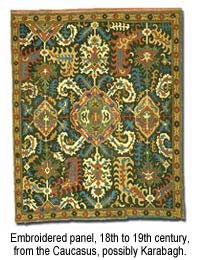Islamic Art: A Growth Market

Islamic art is a fascinating area that’s enjoying renewed interest on the international scene of art collectors.
Origins and History
Islamic art grew from the birth of the religion of Islam in the early 7th century. It spread from its origins in Arabia throughout the Middle East and beyond, with examples of Islamic art still visible in countries as diverse as Spain and India.It has developed and evolved through several eras influenced by the rulers of the day; important eras include the Abbasid, Sassanid, Umayyad and Fatimid periods. Throughout this time, art flourished with the growth of textiles, pottery, ceramics, carving and architectural art.
Important Principles of Islamic Art
Art typified by Islam is a pure expression of the Islamic sprit and its relationship with God. It professes to celebrate spirituality and its timeless and infinite qualities. However, it carefully denounces any attempt to replicate the works or glory of God. It achieves this by differing quite profoundly from Western art and other examples of religious art.There are no examples of religious iconography. This is spurned by the teachings of Islam as a form of idolatry and an attempt to replicate the perfection of God’s creations.
In place of figures, Islamic art depends heavily on patterns and geometry. It is the perfect example of decorative rather than expressive art. This singular quality makes it a very popular focus for lots of art collectors.
Features of Islamic Art
Islamic art beautifully expresses the relationship of the Muslim to their religion and world view. The art mainly comprises geometric patterns which are symmetrical, repetitive and logical. This reflects the Muslim belief that the world and Islam are logical, ordered and infinite concepts.Islamic art is bursting with symbology and common images. The main shapes used are the circle, square and triangle which all express man’s relationship with God and the world. The circle is usually found in the centre or within the basic premise of a work of art. It symbolises the central balance of Islam and unending, radiating harmony which surrounds it. The artwork is embellished by the common images of geometric shapes, floral decoration and calligraphy. The calligraphy often forms an important part of the art, comprising celebratory Qur’anic verses embellished by the surrounding art.
The Growth of the Market
In extraordinary times, Islamic art is enjoying sustained growth. The interest is a positive cultural attempt to close the East and West divisions. It attempts to understand and interpret the place of Islam within modern culture.The rejuvenation of Islamic art in the world of art collecting was encapsulated by the opening of the Victoria and Albert Museum’s Jameel Gallery of Islamic Art in 2006. The gallery houses one of the most extensive and varied collections of Islamic art in the world. The success story is set to continue as 2009 saw the unveiling of the prestigious Jameel Prize for new art inspired by the principles and designs of Islamic art.
Islamic art is a superb expression of the ability of cultural traditions to bring harmony and understanding where politics often fail. The resurgence of interest in Islamic art is set to continue as emerging artists look to Islam as a place of inspiration and insight.
- Corporate Art Collections
- The Royal Art Collection: A Case History
- Amazing Facts About Art Fakes
- Insider Collecting tips - A Five Year Forecast
- Collecting Prints
- The Tax Laws And Art Collecting
- How A Changing Economy Can Affect Art Collecting
- The Importance Of Documenting Your Art Collection
- Collecting Scandals
- Famous Fakes
- Up and Coming Artists
- Art And The Media
- East London & Art
- The BritArt Boom
- London: Capital of the Art World
- The Big Names In Art Collecting
- Top Curators
- The Art Economy


Re: Building up Contacts
Hi. We run a YouTube growth service, which increases your number of subscribers both safety and practically. - We guarantee to gain you…
Re: I Want to Sell a Piece of Art, Where do I Start?
Judy - Your Question:Found a watercolor landscape by LOUIS POHL Signature looks to be in pencil with no…
Re: I Want to Sell a Piece of Art, Where do I Start?
Found a watercolor landscape by LOUIS POHL Signature looks to be in pencil with no date subject is…
Re: I Want to Sell a Piece of Art, Where do I Start?
JustMe - Your Question:I have an original Robert Bliss paining that imp interested in selling. It…
Re: I Want to Sell a Piece of Art, Where do I Start?
I have an original Robert Bliss paining that imp interested in selling. It depicts a beach scene with a…
Re: Building up Contacts
Hi We can help your website to get on first page of Google and increase the number of leads and sales you are getting from your website.…
Re: Hanging Art
@freethie. Sounds interesting. Sorry but we are unable to recommend individual suppliers here. However a search on "art display specialists London"…
Re: Hanging Art
Hi We are planning to display a ceramic exhibition , this will involve hanging pieces from walls around the school , the idea is to cluster them and…
Re: I Want to Sell a Piece of Art, Where do I Start?
Hi, I have limited edition Fabian Perez prints will all documentation of authentication which I would…
Re: Building up Contacts
Do you want to grow your business? Do you have serious, defined sales goals?Reply back to get a full proposal.